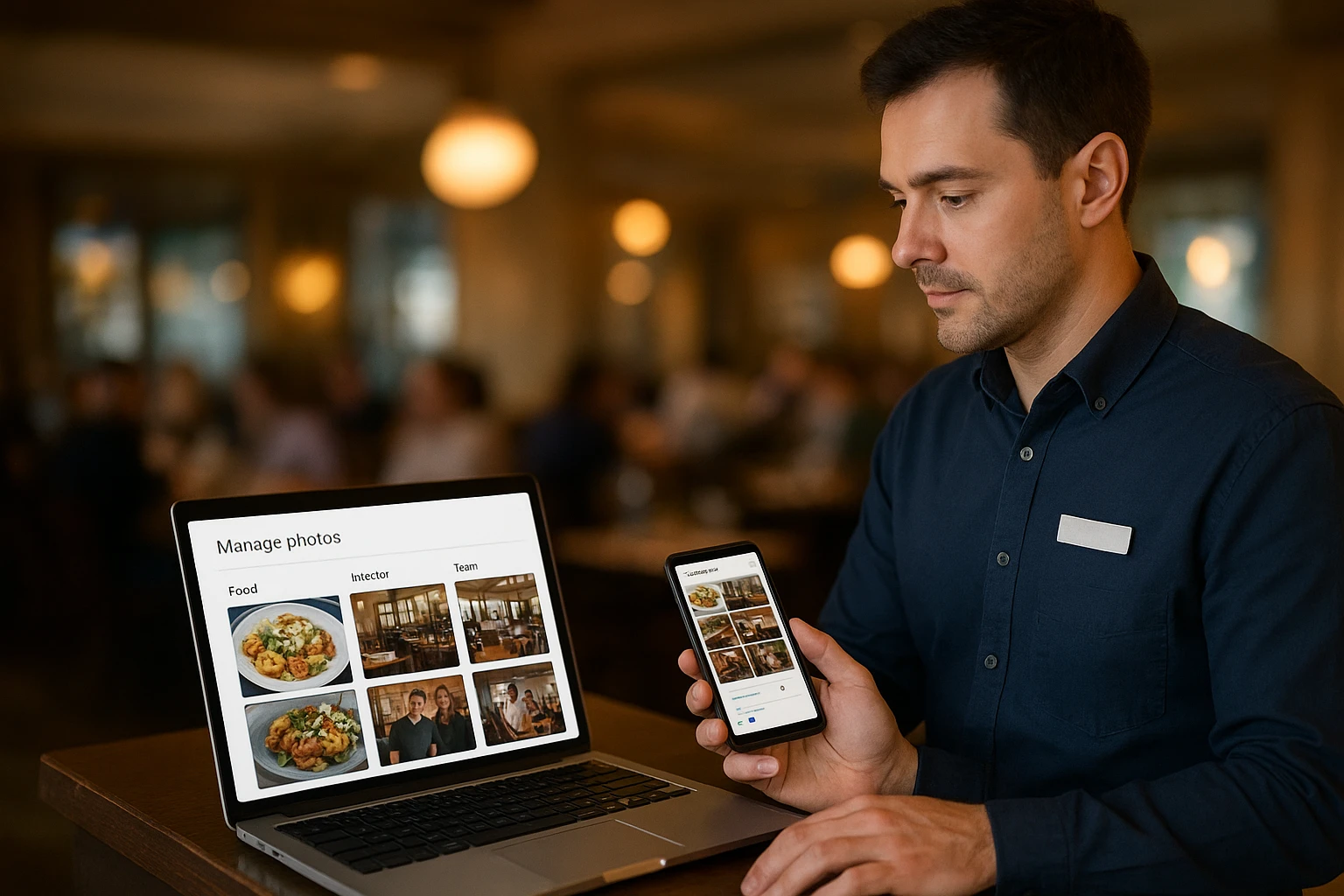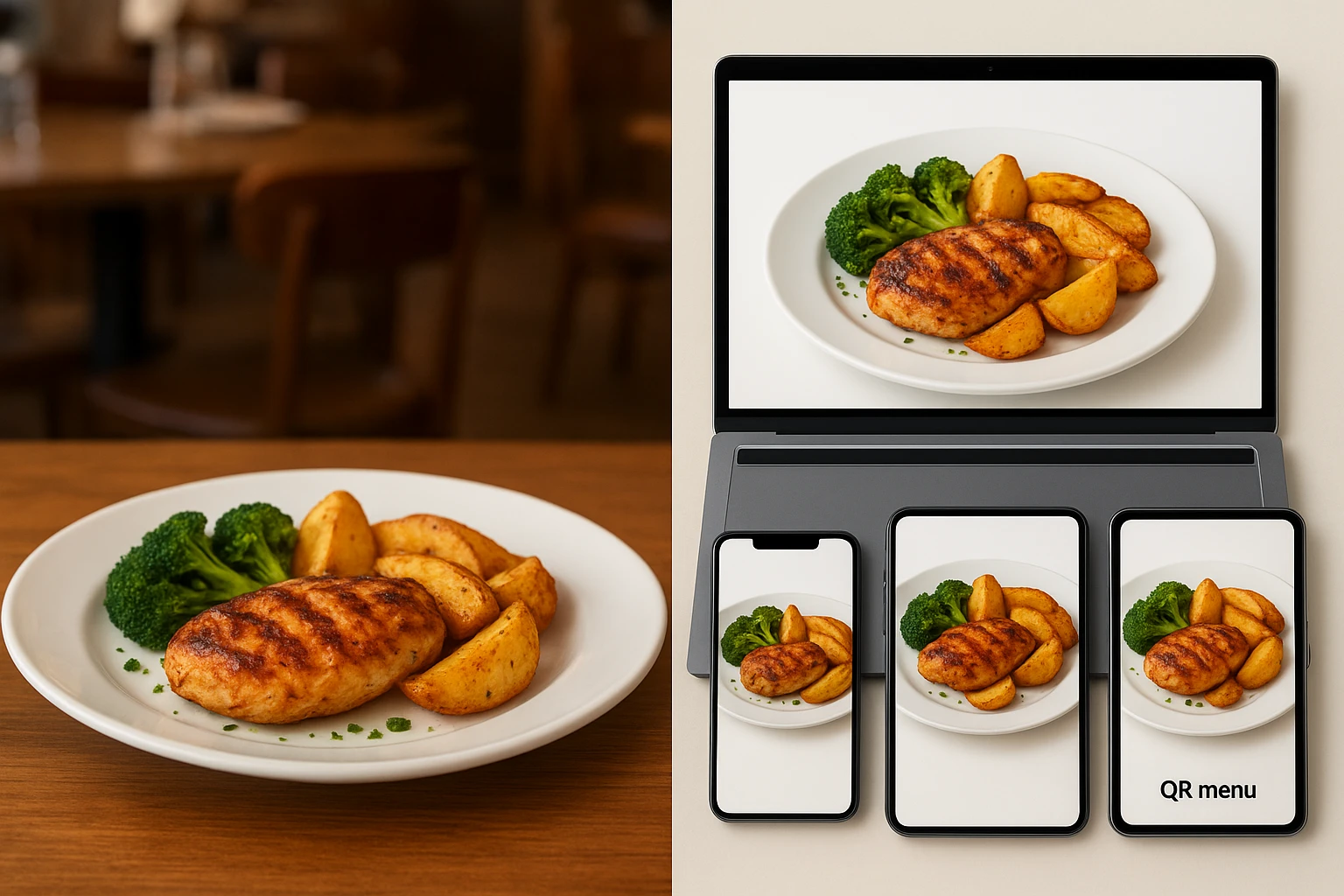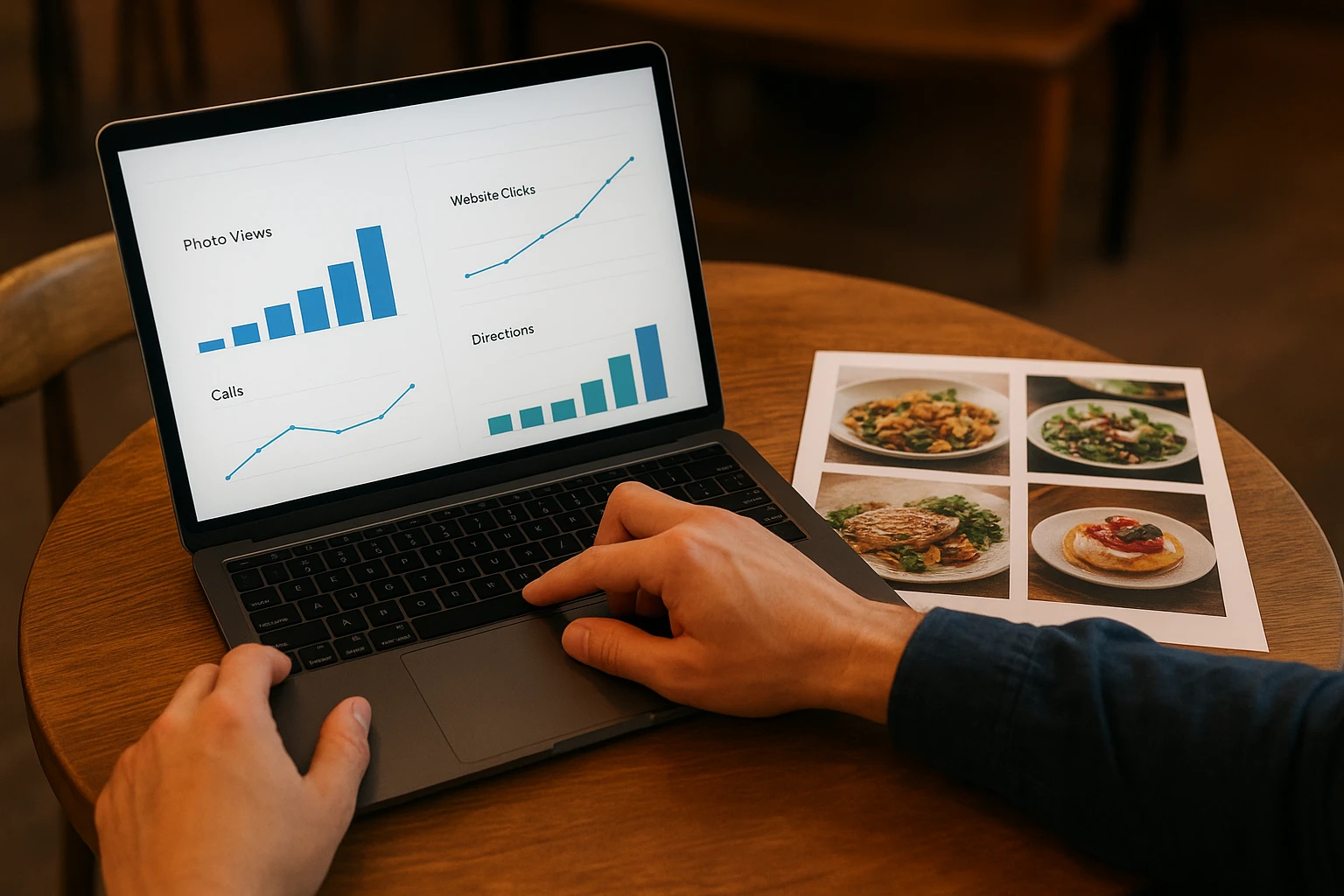Image SEO for Restaurants: Win Google & Maps

Quick navigation:
- 1. Why image SEO now decides who wins on Google & Maps
- 2. Nail the fundamentals: how Google actually reads your photos
- 3. Turn Google Business Profile into a visual front door
- 4. Design an AI-first visual workflow that still feels honest
- 5. Make it measurable: track, test, and iterate your image SEO
1. Why image SEO now decides who wins on Google & Maps
Image SEO Game Plan for Busy Restaurants
| Decision or Task | Recommended Move |
|---|---|
| Primary goal for images | Increase taps and calls from Google Maps and Search (not just “look better”). |
| Where to prioritize first | Google Business Profile gallery, top 10 menu items on your site, and your ordering/QR menu. |
| Format & speed standard | Use compressed WebP/JPEG, under ~200 KB when possible, to protect page speed and Core Web Vitals. |
| Alt text baseline | Describe dish, key ingredients, cuisine, and context in 1 short sentence per image. |
| AI workflow role | Shoot one honest base, then use Yummify to generate on-brand variations for SEO, ads, and delivery platforms. |
It’s 6:30 p.m. on a Friday. Someone zooms in on Google Maps, looks at three nearby restaurants, and taps the listing whose photos look the most appetizing and trustworthy. If your Google Maps restaurant photos are dark, blurry, or outdated, you’re simply not in the race.
That decision has less to do with your food quality and more to do with image SEO for restaurants: how well your photos are labeled, how fast they load, and how clearly they match what searchers want. According to Google’s image SEO guide, search understands images through surrounding text, filenames, structured data, and page context-not just pixels. So your “IMG_1234.JPG” uploaded to a slow menu page isn’t doing much to help you win.
Local specialists consistently rank Google Business Profile (GBP) content-including photos-among the top local pack and Maps ranking factors (BrightLocal’s Local Search Ranking Factors). For restaurants, that’s where the fight for tonight’s covers actually happens.
Why visuals act like a 24/7 host
Think about how guests behave:
- A family scrolling Maps chooses the place whose gallery shows clean tables, full portions, and clear kid-friendly options.
- A catering lead clicks through photos on your GBP to judge whether your platters look good enough for a corporate meeting.
Those taps turn into directions, calls, and orders. Google watches those behaviors and uses them as signals about which listing deserves to show up higher for similar searches.
Where AI food photography changes the math
The problem: traditional shoots cost $150-300 per dish and take weeks to coordinate. That’s why so many restaurants “set and forget” photos for years.
With AI food photography through Yummify, you capture one honest base shot of a dish on your phone, then generate multiple styled versions for:
- Your website menu (wide, fast-loading images)
- Google Business Profile images (bright, square-ish, recognizable)
- Delivery apps and QR menus (tight, conversion-focused crops)
You refresh visuals in hours instead of weeks, without lying about what’s on the plate.
Pause and look at your current Google Maps listing-do your photos actually look like the place you want people to choose tonight?

2. Nail the fundamentals: how Google actually reads your photos
Most restaurant sites already have dozens of photos; they’re just invisible to search. Fixing that starts with a simple checklist.
Image SEO fundamentals checklist for your website
- Rename image files to include restaurant, dish, and city (e.g.,
casa-verde-chicken-enchiladas-austin.webp). - Write one sentence of natural-language alt text describing the dish, key ingredients, cuisine, and context.
- Keep most images under ~200 KB and use WebP or well-compressed JPEG.
- Make sure each photo sits next to relevant text (menu item name, description, or location copy).
- Export consistent dimensions (e.g., 1200?800 for menu heroes, 800?800 for thumbnails).
According to Google’s image SEO best practices, descriptive filenames and nearby text help search understand what each photo represents. The W3C’s alt text guidance adds that alt text should serve humans first-clear, concise, and genuinely descriptive (W3C alt decision tree).
A simple alt text formula
Use this plug-and-play format:
Dish + key ingredients + cuisine + setting.
Examples:
- “Grilled salmon with lemon butter, roasted potatoes, and asparagus at a Seattle waterfront restaurant.”
- “Thin-crust margherita pizza with basil and fresh mozzarella at a neighborhood Italian restaurant in Chicago.”
This supports accessibility for screen readers and tells Google exactly what’s in your restaurant photos.
Speed and format without becoming a developer
Slow images kill mobile restaurant local SEO. Google’s web performance team explicitly recommends modern formats like WebP plus compression to protect Core Web Vitals. Practically, that means:
- Aim for ~100-200 KB per photo for menu and gallery pages.
- Let your website builder’s “optimize image” or “responsive image” options do the heavy lifting.
In a Yummify workflow, you can generate a higher-resolution master, then export web-ready downsized versions so you’re not manually shrinking 5 MB images.
To see how this plays out on Maps, watch this short explainer on how Google monitors restaurant behavior and ranks you in Maps and the local pack:
Pick one high-traffic page-usually your menu-and run through this checklist on every image before moving on.

3. Turn Google Business Profile into a visual front door
Your Google Business Profile is often the first “page” guests see-even before your website. Google explicitly encourages restaurants to upload food, drink, interior, exterior, and team photos, noting that profiles with photos see more direction requests and website clicks (Google Business Profile help).
Local SEO experts repeatedly rank GBP as one of the strongest signals in local pack rankings (BrightLocal research). For restaurants, that translates directly to “Do we get tonight’s walk-ins and deliveries, or does the place next door get them?”
A simple monthly GBP photo plan
| Week | What to upload | Source & workflow | Goal |
|---|---|---|---|
| Week 1 | Top 5 dishes close-ups | Fresh phone shots -> enhance in Yummify -> export GBP size | Win more taps on your signature items. |
| Week 2 | Interior & exterior | Quick photos at lunch and at night; subtle AI cleanup for lighting | Prove the space is clean, busy, and real. |
| Week 3 | Team & behind the scenes | Candid shots; light retouch only (no body changes) | Humanize your listing and build trust. |
| Week 4 | Seasonal specials / promos | One honest base shot -> multiple AI-styled scenes for GBP + social | Create urgency around limited-time offers. |
Example: a taco shop could shoot its best-selling birria tacos once, then use Yummify to create a tight overhead shot for its GBP cover, a lifestyle shot for Instagram, and a simple white-background version for delivery apps.
Keeping it honest while using AI
Guests should recognize the dish that arrives at their table from the photo they saw on Google Maps. Use Yummify to adjust lighting, background, and crop-not to invent ingredients or portions.
Two quick guardrails:
- If your burger never has bacon, don’t let AI add bacon “for style.”
- If your dining room is cozy and dim, brighten photos enough to see clearly, but don’t make it look like a neon club.
Behind the scenes, keep a simple folder system: /GBP/2025-03-top-dishes/, /GBP/2025-03-interior/, etc., so you can quickly find the right exports when you upload.
Open your Google Business Profile and schedule your next four weekly photo uploads right now, even if you only have a few strong images today.

4. Design an AI-first visual workflow that still feels honest
AI should amplify your reality, not replace it. The most sustainable system for AI food photography is simple: one honest base, many variations.
4-step Yummify AI workflow
-
Capture
Train staff to take a clear, well-lit photo of each hero dish once per season. A quick training using the habits in simple capture guides can be enough. -
Style
In Yummify, apply your branded environment: maybe “Bright Taqueria” (colorful tiles, daylight) or “Modern Steakhouse” (dark wood, moody light). This bakes your visual DNA into every image. -
Adapt
Generate channel-specific variations:- Wide hero for your homepage banner
- Square for delivery thumbnails
- Vertical for Reels or Stories
- Medium crop for QR and PDF menus (QR menu best practices)
-
Approve & label
Compare each AI version to the real dish. Reject anything that exaggerates portion size, hides key allergens, or adds ingredients you don’t use. Then label filenames and alt text by dish and channel.
Honest AI in practice
- A vegan cafe keeps the same portion size and garnish but uses Yummify to clean up crumbs and fix harsh shadows.
- A ghost kitchen with no dining room creates consistent, branded backdrops so its food doesn’t look like it was shot on a prep table.
If your menu includes allergen-sensitive items, pair this workflow with the guidance in honest imagery for allergens and dietary claims so photos never contradict your written promises.
Sketch your own “one honest base, many variations” workflow and note where Yummify can save you the most reshoot time.

5. Make it measurable: track, test, and iterate your image SEO
If you don’t measure, image SEO becomes another “nice to have” that slips off the list. The fix is a simple monthly review.
Monthly image SEO review scorecard
| Metric | Where to check | What “good” looks like | Action if it’s low |
|---|---|---|---|
| Photo views vs competitors | GBP Insights | Your photos viewed more than “businesses like you” | Refresh cover and top dishes; upload 5-10 new photos. |
| Website clicks from GBP | GBP Insights | Steady or rising clicks month over month | Test clearer dish photos in posts and main profile images. |
| Directions & calls | GBP Insights | Noticeable lift after major photo updates | Pair strong visuals with GBP posts about offers/events. |
| Menu / ordering clicks | GA or ordering reports | Higher clickthrough on updated-image pages | Use Yummify to roll winning styles to similar dishes. |
Local SEO surveys like BrightLocal’s ranking factors highlight these engagement metrics as critical GBP signals. When your new photos lead more people to click “Website” or “Directions,” you’re sending the right message to Google.
Simple A/B-style testing
You don’t need complex software to test visuals:
- Month 1: Use a dark, moody AI style for your steak photos.
- Month 2: Swap to a brighter, overhead style.
- Track which month drove more calls and menu clicks for that category.
For deeper experiments, the playbook in A/B testing food photos can help you structure tests across delivery apps and your site.
Over time, patterns emerge: maybe bright bowls outperform moody shots for lunch, or family-style platters do better for catering. Feed those insights back into your Yummify presets so every new dish starts from a proven visual direction.
Block 30 minutes on your calendar next month titled “Image SEO review” and duplicate this scorecard as your agenda.

Next steps
If your current photos were taken three chefs ago, you’re leaving money on the table. Capture one honest shot of each hero dish, run them through Yummify to create fast-loading, on-brand variations, and plug them into your website, Google Business Profile, and QR menu. Start with your top 10 items and a single monthly image SEO review-within a few weeks, you’ll know exactly which visuals help you win more taps, calls, and orders from Google and Maps.
FAQ
Do AI-generated food photos actually help my restaurant rank higher in Google Maps and local search?
AI images themselves are not a magic ranking switch, but better visuals can influence the signals Google does care about. When photos are clearer and more appetizing, more people click your listing, view your menu, request directions, and call-those behaviors are part of the engagement mix local SEOs track for the local pack and Maps rankings, as summarized in BrightLocal’s Local Search Ranking Factors. Well-labeled, fast-loading images also help Google understand your content, as described in Google’s image SEO best practices. AI food photography with Yummify simply makes it realistic to keep those high-quality visuals fresh across your menu and Google Business Profile. Over time, that combination of stronger images and healthier engagement can support better visibility in local search results.
Will using AI-enhanced images get my restaurant in trouble with Google or mislead guests?
Used responsibly, AI-enhanced images are simply edited photos, similar to professional retouching. Google’s own image SEO guidance focuses on relevance, accuracy, and technical quality, not the specific tool you use to style the image (Google image SEO guide). The risk comes from misrepresentation-showing ingredients, portions, or ambiance that don’t reflect reality-or from violating platform-specific policies. To stay safe, keep a real base photo for every dish, avoid adding ingredients you don’t serve, and ensure photos for allergen- or diet-specific items match your written claims. This way, AI helps you present your food at its best without misleading guests or creating mismatches between expectations and what arrives at the table.
How many photos should I upload to my Google Business Profile, and how often?
There’s no hard cap, but a practical target for most restaurants is at least 20-50 strong photos covering food, drinks, interior, exterior, and team. Google notes that profiles with photos tend to get more direction requests and website clicks, so it’s worth treating your gallery as a living asset rather than a one-time chore (Google Business Profile help). A realistic cadence is 4-8 new photos per month: one small batch each week focused on a different angle (top dishes, interior, people, seasonal items). That rhythm keeps your listing current, signals ongoing activity to Google, and gives you fresh visuals to reuse on social and your website at the same time.
What’s the simplest way to add alt text and optimized formats if my site uses a template builder?
Most turnkey restaurant builders and template platforms include basic image tools tucked into their media or page editors. Look for fields labeled “alt text” or “image description” and add one sentence that clearly describes the dish, ingredients, cuisine, and setting-aligned with accessibility best practices from the W3C alt text decision tree. For formats and compression, many platforms now auto-convert uploads to WebP or optimized JPEG and serve responsive sizes, following the performance advice in Google’s image optimization guide. If yours doesn’t, you can export smaller WebP/JPEG files from Yummify first so you aren’t uploading multi-megabyte originals. Even these small steps dramatically improve how search engines understand and load your photos.
Can I A/B test different AI food photo styles without breaking brand consistency across locations?
Yes, as long as you separate “brand rules” from “test variables.” Start by defining non-negotiables: angles you always use, typical lighting, color palette, and how full plates should look. Within that framework, you can test controlled differences-such as slightly darker vs. brighter styling, tighter vs. looser crops, or different background textures-while keeping the core visual identity consistent. Multi-unit operators often document these rules in a styling guide, then use tools like Yummify to apply the same branded environment across all locations. That lets you run style tests on specific dishes or campaigns and measure results by location without ending up with a chaotic, off-brand gallery.
How do I know if new AI-powered visuals are actually driving more orders, not just more photo views?
Start by monitoring Google Business Profile Insights for changes in website clicks, calls, and direction requests after major photo updates-these are closer to real intent than raw photo views alone. Then compare those trends with your internal metrics: online orders for highlighted dishes, reservation volume, or catering inquiries for items you recently re-shot. Local SEO research, such as BrightLocal’s ranking factor surveys, emphasizes that stronger engagement signals on GBP can support better visibility, which in turn feeds more opportunities to convert. To go deeper, use a simple before/after window (for example, 30 days before vs. 30 days after a batch of Yummify images) and review dish-level sales where possible. If a particular visual style lines up with higher clickthrough and better sales for that item, you’ve got a strong signal to replicate it across similar menu categories.


